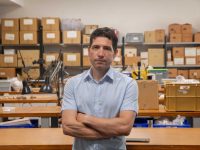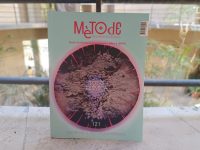
18th century drawing (Private Collection) by Mme. Lavoisier of «Pneumatic» laboratory scene in Lavoisier’s laboratory, showing Mme. Lavoisier on the far right and Lavoisier in the centre. / Istituto di Storia della Scienza, Firenze
Can scientific facts and the idiosyncratic tribal culture of scientists be presented persuasively and intelligibly in the form of «science-in-fiction» and «science-in-theatre»? Here, some affirmative examples are given, emphasising the play Oxygen.
Science and Literature is a huge topic, which can only be covered superficially within the confines of a short article. Therefore, I have chosen to address it within the restricted confines of my own experience: as a chemist, who after half a century of research –the results of which I described in well over a thousand articles in the scientific literature– decided to reinvent himself by focusing on «true» literature, which for my present purpose means fiction and theatre plays. The personal reasons that caused my own transformation from scientist to author of fiction and plays need little elaboration, since I have described them in a memoir (Djerassi, 2003). Instead, let me narrow the focus even further by using in this Year of Chemistry, my own discipline as the science to be examined through the lens of literature.
Chemistry in literature
Without quantitative evidence, I would generalise and say that chemistry is probably the scientific discipline that is least widely represented in fiction or in the theatre compared to medicine or even physics. Similarly, in spite of the fact that some superb literati like Primo Levi or Elias Canetti were also chemists, I am under the impression that there are far fewer chemist-authors in literature than say medically trained scientists. Why?
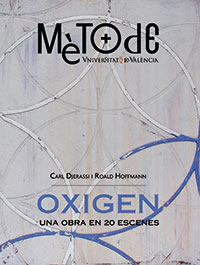
Portada de l’obra Oxigen, publicada per Mètode dins de la seua col·lecció de monografies. Aquesta obra de teatre de Carl Djerassi i Roald Hoffmann s’ha traduït a setze idiomes, entre ells el català.
Is it because chemists use mostly chemical structures rather than just words and thus find it difficult to communicate even within their own specialty, let alone the general public, without recourse to blackboard or slides or some other kind of pictogram? Or is it because chemists deal almost exclusively with abstractions at the molecular level, whereas physicians spend their days listening to the stories of other human beings? After all, even the most scientifically-invested novels or plays succeed, if they do, because they work at the human level. Finally, let me add another hurdle why so few chemists write plays. Since the time of Galileo most formal written discourse of scientists is monologist or indirect, whereas the theatre is the realm of dialogue.
What caused me, a scientist from a very hard science, chemistry, to cross over into fiction to become an intellectual smuggler? Somewhat late in life, in my middle sixties, I decided to help bridge the ever-widening gulf between science and popular culture in a somewhat unorthodox way, and to do it through a genre I call «science-in-fiction» –not to be confused with science fiction–. For me, a novel can only be anointed as «science-in-fiction» if all the science or idiosyncratic behaviour of scientists described in it is real or at least plausible. None of these restrictions apply to science fiction. By no means am I suggesting that the scientific flights of fantasy in science fiction are inappropriate. But if one actually wants to use fiction to smuggle facts about science into the consciousness of a scientifically illiterate public –and I do think that such smuggling is intellectually and societally beneficial– then it is crucial that the facts are described accurately. Otherwise, how will the scientifically uninformed reader know what is presented for entertainment and what for the sake of factual knowledge?
But of all literary forms, why use fiction? The majority of scientifically untrained persons are afraid of science, often murmuring, «I don’t understand science», while dropping a mental curtain, the moment they learn that some scientific facts are about to be sprung on them. It is that portion of the public –the ascientific or even antiscientific reader– that I want to touch. Instead of starting with the aggressive preamble, «let me tell you about my science», I prefer to start with the more innocent «let me tell you a story» and then incorporate realistic science and true-to-life scientists into the plot. But rather than describe primarily what scientific research we scientists perform, I wanted to focus on illustrating how scientists behave. And it is here that a scientist-turned-author can play a particularly important role, because scientists operate within a tribal culture whose rules, mores and idiosyncrasies are generally not communicated through specific lectures or books, but rather are acquired through a form of intellectual osmosis in a mentor-disciple relationship. To me –as a scientific tribesman for over five decades– it is important that the public does not look at scientists primarily as nerds, Frankensteins or Strangeloves. And because science-in-fiction deals not only with real science but more importantly with real scientists, I feel that a clansman can best describe a scientist’s tribal culture and behaviour. As an example of the many topics that I felt warranted illumination behind the scrim of fiction, let me refer the reader to the last novel, entitled NO (Djerassi, 1998) in my science-in-fiction tetralogy. I selected it because it shows what range of science-related topics can be encompassed within the pages of a single novel: the chemistry of Nitric Oxide, its biological role in penile erection, its commercialisation through the establishment and operation of a typical biotech company (based on a real case study in Silicon Valley), the struggles of women in the still male-dominated culture of science, the increasing Asianisation of American science, and finally the reappearance in NO of all the characters of the preceding three novels. But this seeming braggadocio also requires an important caveat.
My desire to use my novels to smuggle information into the minds of an innocent reader clearly has didactic motives and probably originates from my ingrained habit as a scientist, since scientific writing serves mostly as a vehicle for information transmittal. Yet the word «didactic» is usually a pejorative one when employed in fiction or theatre. In spite of this, I believe that the Roman poet Horace justified persuasively its judicious use in his famous prescription from Ars Poetica: «Lectorem delectando pariterque monendo»[delighting the reader at the same time as instructing him].
Science in theatre
So let me turn to the theatre to make the most persuasive argument why gentle touches of didacticism interspersed throughout a text need not be fatal. In a recent book of mine (Djerassi, 2008), I explained why the use of dialogue has so attracted me:

Imatge del 2001, darrere, i de 1777, en primer terme, en el muntatge d’Oxigen de la producció de Costa Rica, al Teatre Nacional de San José, 2010. / Col·lecció privada C. Djerassi
One reason has to do with my own biography. In my previous incarnation as a scientist for more than half a century, I was never permitted, nor did I allow myself, to use direct speech in my written discourse. With very rare exceptions, scientists have completely departed from written dialogue since the Renaissance, when, especially in Italy, some of the most important literary texts were written in dialogue form. They could be expository or even didactic, to conversational or satirical, that attracted both readers and authors. Galileo is a splendid case in point. And not just in Italy. Take Erasmus of Rotterdam, his colloquies are a marvellous example how one of the Renaissance’s greatest minds managed to cover in purely dialogic form topics ranging from «Military Affairs» (Militaria) or «Sport» (De lusu) to «Courtship» (Proci et puellae) or «The Young Man and the Harlot» (Adolescentis et scorti). This explosion of dialogic writing even stimulated literary-theoretical studies. From the sixteenth century on, critics have attempted to exalt, defend, regulate or, alas, to abolish this genre of writing, which on occasion has been defined as closet drama: theatre to be read rather than performed.
Nowadays, the exclusive use of direct speech is only practiced in theatrical writing, which is one of the reasons why I have chosen the theatre for my literary activities during the past dozen years.
Science is inherently dramatic –at least in the opinion of scientists– but does it follow that scientists are dramatic personae, or that science can become the stuff of drama? To me an equally important question is whether «science-in-theatre» can also fulfil an effective pedagogic function on the stage, or are pedagogy and drama antithetical? Must the urge to educate be an automatic kiss of death when writing for the commercial theatre? «Didactic», which is code for «boring», is usually the most damning term a reviewer can use to drive a prospective audience from a play.
As I have stated on more than one occasion, it is the conviction of many scientifically untrained persons that they are unable to comprehend scientific concepts which stops them from even trying. For such an audience, rather than an unadorned lecture, «case histories» can be a more alluring as well as more persuasive way of overcoming such hurdles. If such a story-telling «case history» approach involving science or scientists is employed on the stage rather than on the lectern or the printed page, then we are dealing with «science-in-theatre» (for a less restricted view see Zehelein, 2009).
An Immaculate Misconception
To test the waters, I selected as the topic for my first play, «An Immaculate Misconception», the impending separation of sex (in bed) and fertilisation (under the microscope) since I consider this one of the fundamental issues facing humanity during the coming century. For the scientific component of my play, I chose the most ethically charged reproductive technology of them all, ICSI (intracytoplasmic sperm injection, meaning the direct injection of a single sperm into the egg). I suspect that few will argue with my assumption that everyone has opinions about reproduction and sex, and that most people of theatre-going age are convinced that they know the facts of reproductive life. But do they really? I would offer odds that few in such an audience could even answer correctly the following simple question: While it takes only a single sperm to fertilise an egg, how many sperm must a man ejaculate in order to be fertile? Answer: a fertile man ejaculates on the order of 50 to 100 million sperm during intercourse; a man ejaculating 1 to 3 million sperm –seemingly still a huge number– is functionally infertile. Less than 20 years ago, there was no hope for such men. But now, many can become fathers because of ICSI. Yet how many members of the theatre audience I wish to attract have heard of ICSI? Once they have seen the play, they will never forget it.
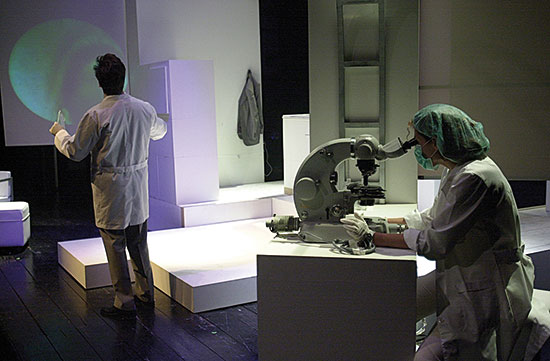
Laboratori de la producció en portuguès (Esse Espermatozoide e meu!) d’An Immaculate Misconception, al Teatre do Trindade, de Lisboa, de 2004./ Col·lecció privada C. Djerassi
The relatively rapid acceptance of my first play –so far translated into 12 languages and also broadcast by the BBC World Service, NPR (USA), WDR (Germany), and the Swedish and Czech Radios as well as published in book form (Djerassi, 2000)– can in large part be ascribed to the timeliness of the topic and the inherently dramatic aspects of human reproduction that in An Immaculate Misconception were presented so graphically –a feature commented upon by all the reviewers–.
Oxigen: the gas and the play
But as a chemist turning into a playwright, it behooved me to see whether chemistry can be presented as effectively on the stage as, say, sex. I had the good fortune to find a partner, Roald Hoffmann, interested in joining me in such a theatrical experiment. In 1981, he was awarded the Nobel Prize in Chemistry for his theoretical chemical insights. But unlike most chemists, he has been interested for years in communicating with a broader public, and has done so through his own poetry and non-fiction writing.
Just as I tried in my first play to hide my didactic motivations behind the scrim of sex, in the second play, Oxygen, Hoffmann and I did this by taking up a theme –the Nobel Prize– that, at least to scientists, is potentially also sexy. The year 2001 was the centenary of the Nobel Prize; it is also the year in which our play is set. In Oxygen, we postulated that the Nobel Foundation decided to celebrate the centenary by establishing a new Nobel Prize, termed a «retro-Nobel», to honour inventions or discoveries made before 1901, the year when the first Nobel Prizes were awarded.
In addition to describing in dramatic fashion the history of the discovery of oxygen, our play attempts to deal with two fundamental questions: what is discovery in science and why is it so important for a scientist to be first? In Oxygen, we approach these questions as our imaginary retro-Nobel Committee meets to select, first, the discovery that should be so honoured, and then which scientist to credit for it. Here is an early scene in which the chair of the retro-Nobel committee, Astrid Rosenqvist, debates the issue with her male colleagues:
Astrid Rosenqvist: Now let me summarise whom we’ve got so far: John Dalton as father of the atomic theory… Dimitri Ivanovitch Mendeleyev for inventing the Periodic Table… August Kekulé for the structure of benzene… and of course, Louis Pasteur…. All of them first class… and a nice geographic spread: an Englishman, a Russian, a German, and a Frenchman.
Ulf Svanholm: And for a changeno American!
A. Rosenqvist: Another advantage for concentrating on the 19th century. But we also agreed that these four are candidates for a later retro-Nobel. The first one must recognise where modern chemistry began.
Sune Kallstenius: In other words… with the discovery of oxygen.
A. Rosenqvist: Who’d like to come up with some simple phrases to explain to the public that without the discovery of oxygen there would’ve been no chemical revolution… no chemistry as we now know it?
Bengt Hjalmarsson: I’ll give it a try. Prior to Antoine Lavoisier…
S. Kallstenius: You mean prior to Carl Wilhelm Scheele…
U. Svanholm: What about Joseph Priestley?
B. Hjalmarsson: ºRight back to the usual Nobel quandary! Too many candidates.
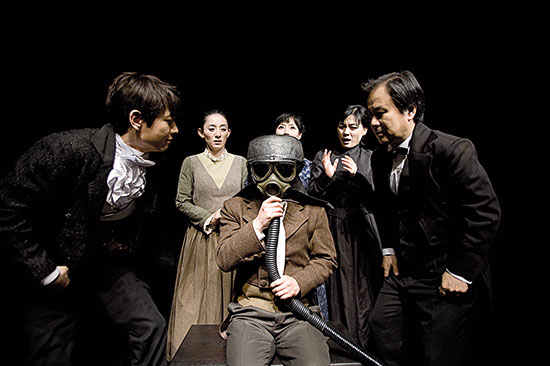
Laboratori «pneumàtic» de la producció coreana d’Oxigen, al KCAF Arts Theatre, Seül 2006. / Col·lecció privada C. Djerassi
Throughout the play, as the retro-Nobel Committee debates its selection, the audience learns about the three leading candidates through a trialogue during a royal adjudication concerning the respective claims of the Swedish apothecary Carl Wilhelm Scheele (who made it first); the English minister-turned-chemist, Joseph Priestley (who published first); and the French chemist, tax collector, economist, and public servant, Antoine Laurent Lavoisier (who understood it first). In switching back and forth between 2001 and 1777, we present the historical and personal record that leads the Nobel Committee to its final conclusion.
Scheele: Resolve the question «Who made fire air first?» That was His Majesty’s command… to all three of us.
Lavoisier: Is that the real question?
Priestley: Of course. And you, Monsieur Lavoisier… did not make that air first… as you yourself in effect conceded yesterday.
Lavoisier: I understood it first…
Scheele: Understanding only comes after existence!
Priestley: But my dear Scheele! Proof of such existence must be shared!
Lavoisier: But certainly not years ago as you now claim. (Impatient) What is the real purpose of this meeting?
Priestley: Priority! In August 1774 I made dephlogisticated air… your oxygen…
Lavoisier: Then you thought you had nitrous air, sir.
Priestley: More than once, my experiments in pneumatic chemistry were cited by you.
Lavoisier: Is that a reason to complain?
Priestley: You write, «We did this… and we found that». Your royal «we», sir, makes my contributions disappear… poof… into thin air! When I publish, I say, «I did… I found… I observed». I do not hide behind a «we».
Lavoisier: Enough of generalities… or platitudes. What now?
Priestley: The question, sir! The question! Who made that air first?
Scheele: I did. I, Carl Wilhelm Scheele of Köping. And future generations will affirm it.
Priestley: But by the grace of God, I made it too… I, Joseph Priestley, and published first!
Lavoisier: They knew not what they’d done… where oxygen would lead us.
Science plays as science books
To date, Oxygen has been translated into 16 languages, which brings me to a final point that applies also to all the other six plays I have since written. Are contemporary plays solely suited for occasional presentation on the stage or are they also texts that merit to be read on their own like a standard book? In other words are they solely to be used in «show, don’t tell» fashion on the stage or also in a «tell, don’t just show» manner within the covers of a book, something that is generally only done in canonical plays by classical authors like Shakespeare, Schiller or Molière? I am a firm believer that some contemporary plays merit such double exposure and that Oxygen —now published in book form in eight languages (see for instance Djerassi & Hoffmann, 2001)— falls into that category.
REFERENCES
Djerassi, C., 2001. La píldora de este hombre: Reflexiones en torno al 50 aniversario de la píldora. Fondo de Cultura Económica. Mèxic, DF.
Djerassi, C., 2002. Inmaculada concepción furtiva: El sexo en la era de la reproducción mecánica. Fondo de Cultura Económica. Mèxic, DF.
Djerassi, C., 2003. NO. Fondo de Cultura Económica. Mèxic, DF.
Djerassi, C., 2010. Cuatro judíos en el Parnaso—Una Conversación. Capital Intelectual, Buenos Aires.
Djerassi, C., i Hoffmann, R., 2003. Oxígeno. Fondo de Cultura Económica. Mèxic, DF.
Zehelein, E-S., 2009. Science: Dramatic. Science Plays in America and Great Britain, 1990 – 2007. Universitätsverlag Winter. Heidelberg.



